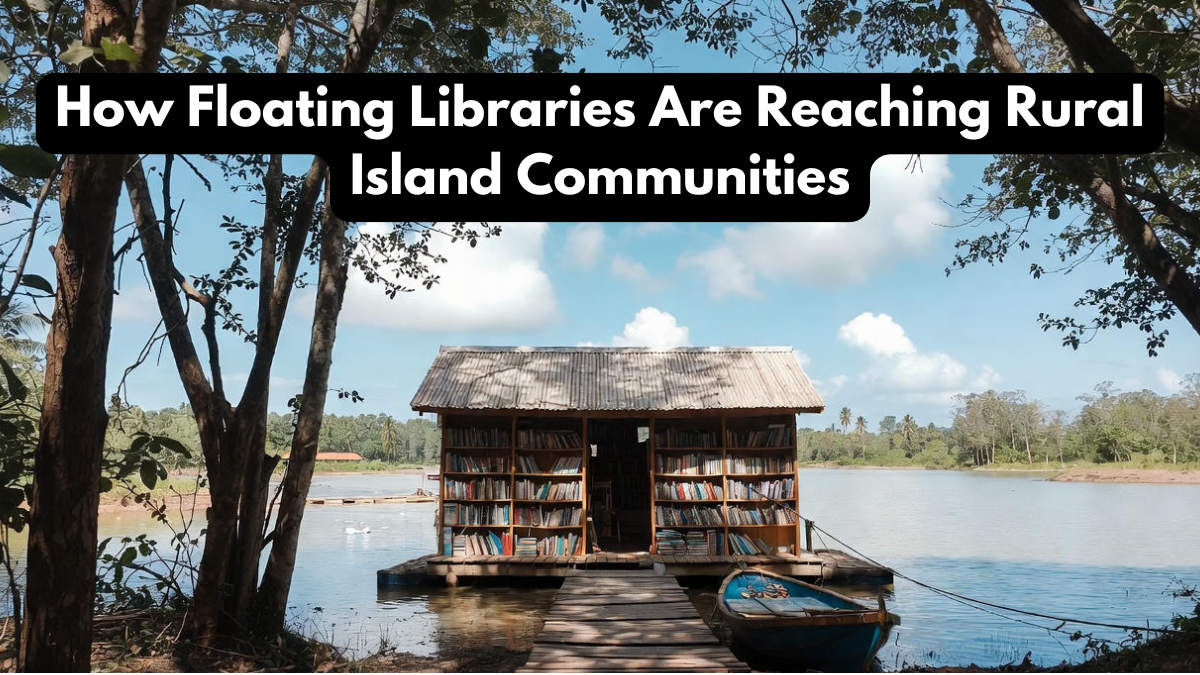Education access in remote and underserved regions has always been a major challenge in many developing countries. In response to this long-standing issue, a remarkable initiative featuring floating libraries rural has begun transforming literacy and learning in isolated island and riverbank communities. These floating libraries operate on boats, ferries, or barges and deliver books, digital learning tools, and educational programs directly to people who lack access to schools or public libraries. This unique model represents one of the most impactful examples of innovative education access, demonstrating how creative thinking can bridge education gaps where traditional infrastructure falls short.

Why Floating Libraries Are Becoming Necessary
Rural and riverine regions often face geographic barriers that make building traditional libraries and schools costly or impractical. Islands, flood-prone villages, and remote riverbanks frequently remain cut off from mainstream education systems. The launch of floating libraries rural directly addresses these challenges by bringing learning resources to the doorstep of such communities.
These initiatives are strongly aligned with the goals of innovative education access, offering children and adults opportunities to read books, access digital study materials, and participate in learning programs without needing to travel long distances. By reaching the most isolated areas, floating libraries are promoting inclusivity and ensuring that no community is left behind in the pursuit of literacy.
Key Features of Floating Libraries
Floating libraries are not just boats carrying books—they are fully functional mobile learning centers equipped with educational tools and trained facilitators. The floating libraries rural model ensures that learners in hard-to-reach areas benefit from a wide range of resources.
Common features include:
- Shelves filled with age-appropriate books
- Tablets or laptops with offline educational content
- Storytelling corners for children
- Trained librarians and educators onboard
- Solar-powered lighting and charging units
- Educational games and community workshops
- Safe seating areas for group learning
These features reflect the broader mission of innovative education access, making learning engaging and accessible even in areas without proper school infrastructure.
Table: Traditional Rural Libraries vs. Floating Libraries
| Feature | Traditional Rural Libraries | Floating Libraries |
|---|---|---|
| Accessibility | Limited due to distance | High due to floating libraries rural mobility |
| Infrastructure Cost | High | Lower, affordable |
| Technology Availability | Often minimal | Enhanced through innovative education access |
| Learning Programs | Irregular | Regular, scheduled visits |
| Resilience During Floods | Vulnerable | Highly adaptive |
| Community Engagement | Low to moderate | High due to mobility and novelty |
This comparison highlights the efficiency and inclusiveness of floating educational models.
How Floating Libraries Operate in Rural Regions
Floating libraries rural initiatives follow well-planned routes, stopping at designated locations on specific days. Communities gather along riverbanks, docks, or shorelines when the library boat arrives. Once docked, children rush to borrow books, attend reading circles, and participate in storytelling sessions. Adults join literacy workshops, career guidance seminars, or digital training programs.
This approach is a powerful example of innovative education access, as it brings consistent learning opportunities to communities without requiring them to commute or relocate. Floating libraries also adapt their routes during monsoon seasons or flooding, ensuring uninterrupted access to educational resources.
Community Impact and Social Transformation
Floating libraries have created a major social impact in rural and island communities. Children who previously had limited exposure to books are now developing reading habits and performing better academically. Parents and elders benefit from adult literacy programs, vocational workshops, and access to information related to health, farming, and livelihoods.
This growing movement of floating libraries rural is helping bridge generational literacy gaps. Communities that once lacked learning environments are now experiencing improved educational outcomes. These benefits align with the broader objectives of innovative education access, supporting long-term societal development through knowledge and empowerment.
Role of Technology and Digital Learning
Technology plays a crucial role in enhancing the effectiveness of floating libraries rural initiatives. Many boats are equipped with tablets, e-learning apps, and digital multimedia content. Solar panels provide power, ensuring access to reading light and device charging even in areas without electricity.
Digital learning tools support innovative education access by offering video lessons, animated learning modules, and offline tutorials for students preparing for exams. This combination of traditional books and digital education makes floating libraries versatile and future-ready.
Sustainable Expansion and Future Prospects
With increasing recognition of their impact, more regions are adopting the floating libraries rural model. NGOs, government departments, and international education agencies are collaborating to expand these libraries across major river systems, including the Ganges, Brahmaputra, and Godavari.
The future of these libraries is closely tied to advancements in innovative education access, with plans to introduce floating science labs, mobile computer classrooms, and skill-building workshops. As awareness grows, floating libraries are expected to become a cornerstone of rural education strategies.
Conclusion
The rise of floating libraries rural represents a groundbreaking step toward inclusive and equitable education. By bringing books, digital tools, and learning opportunities directly to remote water-bound communities, these libraries exemplify the essence of innovative education access. They empower children and adults, bridge educational gaps, and strengthen community engagement. As more regions adopt this model, floating libraries will continue to transform rural education, ensuring that knowledge reaches every corner—no matter how remote.
FAQs
What are floating libraries?
Floating libraries are mobile learning centers on boats, designed to support floating libraries rural education.
Why are they important for rural areas?
They improve literacy and ensure innovative education access for regions without permanent schools or libraries.
Do floating libraries include digital learning tools?
Yes, many boats are equipped with tablets and offline content powered by innovative education access systems.
How often do these libraries visit communities?
Visits vary by region, but floating libraries rural typically follow a fixed schedule.
Who funds and manages floating libraries?
They are often supported by NGOs, government programs, and community groups promoting innovative education access.
Click here to know more.